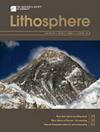3D Plotting of Gold Solubility and Gold Fineness: Quantitative Analysis of Ore-Forming Conditions in Hydrothermal Gold Deposits
IF 1.7
4区 地球科学
Q3 GEOCHEMISTRY & GEOPHYSICS
引用次数: 0
Abstract
Abstract The 3D plotting of gold solubility and gold fineness aims to illustrate how to quantify their correlations with ore-forming conditions in hydrothermal gold deposits. The thermodynamic calculation of the Au-Ag solid solutions in Mathematica and the 3D plotting in MATLAB are used to build isopleths of gold solubility and gold fineness at different temperatures (200℃, 400℃), pressures (0.1, 5 kbar), salinities (1, 40 wt% NaCl eq.), and sulfur concentrations (0.01, 0.5 mol/kg). The plot indicates that the ore-forming conditions have different correlations with gold solubility and gold fineness. Average rates of change for the correlations are quantified, showing distinct values in the four pH-logfO2 fields of (I) HSO4−, (II) SO42−, (III) H2S, and (IV) HS−, where dominant gold and silver complexes have different dependencies on the conditions. The quantification of the plots illustrates that a decrease in gold solubility by one order of magnitude is possibly caused by a decrease in temperature of ≥40℃, the salinity of ≥9.6 wt% NaCl eq. or sulfur concentration of ≥0.14 mol/kg, or an increase in pressure of ≥3 kbar, while a decrease in gold fineness by 100 units is possibly caused by a decrease in temperature of ≥14 ℃, pressure of ≥1.4 kbar, or salinity of ≥4 wt% NaCl eq., or an increase in sulfur concentration of ≥0.07 mol/kg. Quantification results suggest that a sharp decrease in temperature may result in large-scale gold mineralization and a great variation in gold fineness. In addition, the quantification reveals that the correlation between gold solubility and gold fineness can be expressed by a function, providing a rapid method for 3D plotting.金溶解度和金细度三维标绘——热液金矿成矿条件定量分析
摘要热液金矿床中金溶解度和金细度的三维标绘旨在说明如何量化它们与成矿条件的相关性。利用Mathematica软件对Au-Ag固溶体进行热力学计算,并用MATLAB软件进行三维绘图,建立了不同温度(200℃、400℃)、压力(0.1、5 kbar)、盐度(1.40 wt% NaCl eq.)和硫浓度(0.01、0.5 mol/kg)下的金溶解度和金细度等层。该图显示成矿条件与金溶解度、金细度有不同的相关性。相关性的平均变化率被量化,在(I) HSO4−,(II) SO42−,(III) H2S和(IV) HS−的四个pH-logfO2场中显示出不同的值,其中主要的金和银配合物对条件有不同的依赖性。情节的量化说明黄金溶解度下降一个数量级可能是由于温度下降≥40℃、≥9.6 wt %的盐度氯化钠eq.或硫浓度≥0.14摩尔/公斤,或≥3千巴压力的增加,同时减少黄金细度在100年单位可能是由于温度下降≥14℃,压力≥1.4千巴,或盐度≥4 wt %氯化钠eq。,或增加硫浓度≥0.07摩尔/公斤。定量结果表明,温度的急剧下降可能导致大规模的金矿化和金细度的巨大变化。此外,定量分析表明,金溶解度与金细度之间的相关性可以用函数表示,为三维绘图提供了一种快速的方法。
本文章由计算机程序翻译,如有差异,请以英文原文为准。
求助全文
约1分钟内获得全文
求助全文
来源期刊

Lithosphere
GEOCHEMISTRY & GEOPHYSICS-GEOLOGY
CiteScore
3.80
自引率
16.70%
发文量
284
审稿时长
>12 weeks
期刊介绍:
The open access journal will have an expanded scope covering research in all areas of earth, planetary, and environmental sciences, providing a unique publishing choice for authors in the geoscience community.
 求助内容:
求助内容: 应助结果提醒方式:
应助结果提醒方式:


